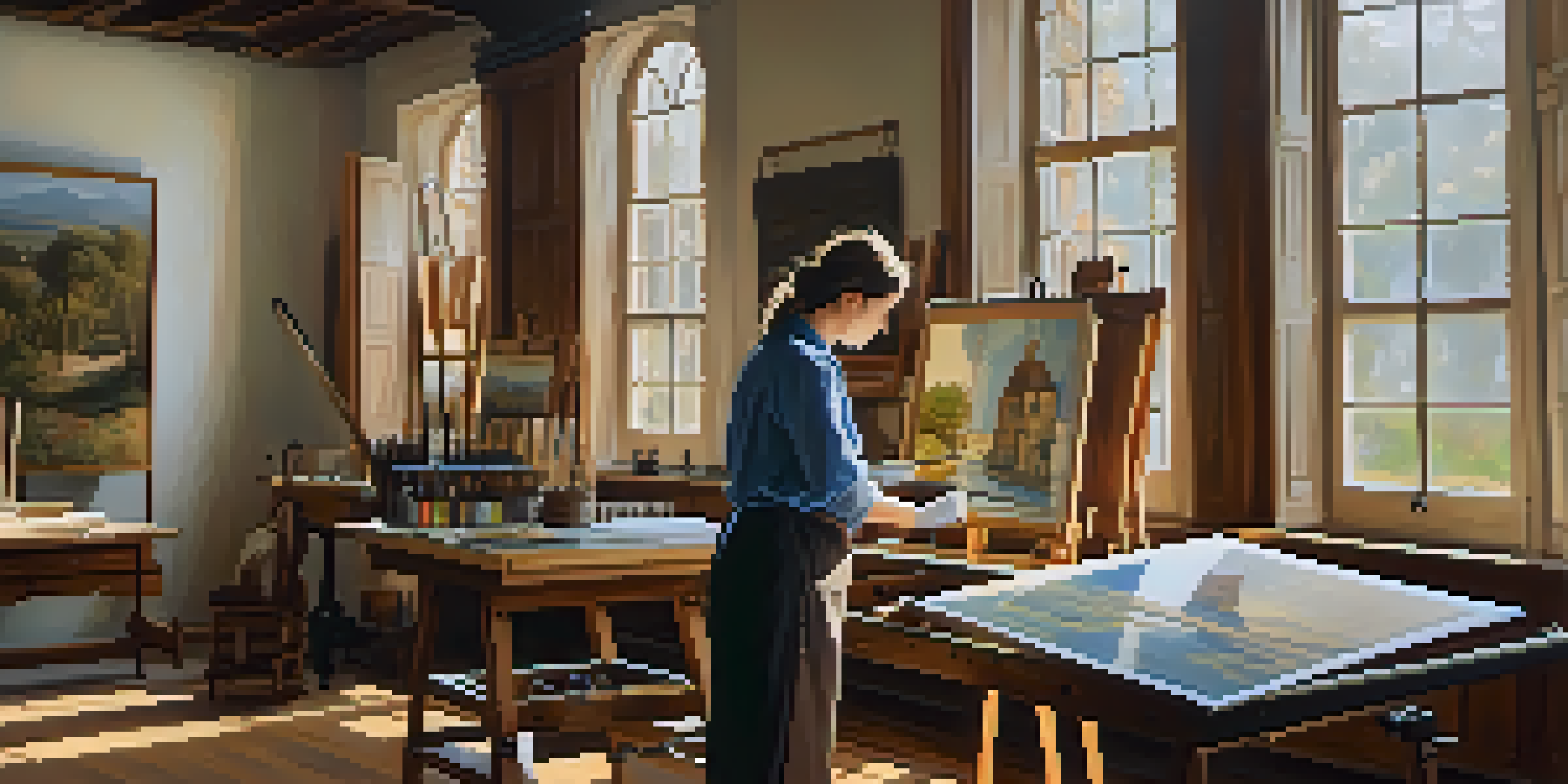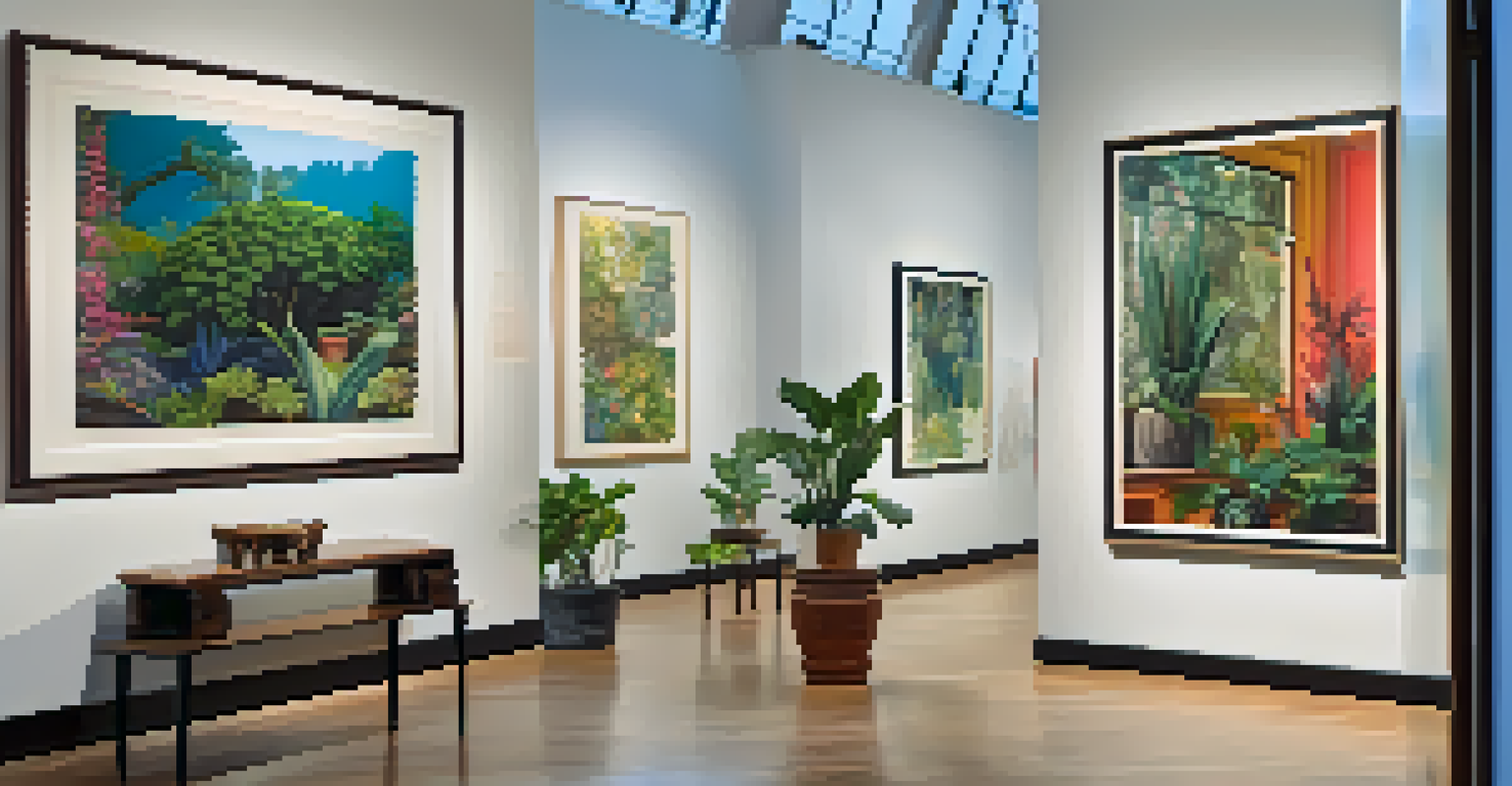Preventive Conservation: Protecting Art Before Damage Occurs

Understanding Preventive Conservation in Art Preservation
Preventive conservation is all about safeguarding art before any damage occurs. It involves strategies that minimize risks and ensure artworks remain in optimal condition. Think of it as a preemptive health check for your favorite painting or sculpture.
The best way to preserve art is to keep it safe from the elements that could destroy it.
By assessing environmental factors like temperature, humidity, and light exposure, conservators can create a tailored preservation plan. This approach helps mitigate potential threats that could jeopardize an artwork's integrity over time. Just like how we take care of our health by eating right and exercising, artworks need proper care too.
Ultimately, preventive conservation is about being proactive rather than reactive. Instead of waiting for an artwork to sustain damage, conservators take steps to protect it from the outset, ensuring that future generations can appreciate these cultural treasures.
The Role of Environmental Control in Conservation
Environmental factors play a crucial role in the deterioration of artworks. High humidity levels can promote mold growth, while excessive light can cause fading. Therefore, monitoring and controlling these conditions is vital to preserving art.

For instance, museums often use specialized climate control systems to maintain stable temperature and humidity levels. This is akin to how we adjust our home heating or air conditioning to stay comfortable throughout the seasons. Such systems help create an environment that minimizes the risk of damage.
Preventive Conservation Essentials
Preventive conservation focuses on proactively safeguarding artworks by managing environmental factors and implementing best practices.
By understanding and managing these environmental aspects, conservators can significantly extend the lifespan of artworks. This proactive approach not only protects the art but also enhances the overall experience for visitors, allowing them to enjoy the beauty of these pieces without the worry of them deteriorating.
Handling Art with Care: Best Practices
When it comes to handling art, best practices are essential to prevent accidental damage. For example, wearing gloves when touching artworks can help avoid leaving fingerprints or oils that can degrade the surface. This simple step can make a world of difference.
Art is not a thing; it is a way. It is not just about creating; it's about preserving and cherishing.
Moreover, using appropriate tools and techniques during installation or movement is crucial. Just as you wouldn’t use a standard knife to cut delicate cake, conservators use specialized equipment to ensure that artworks are treated with the utmost care. This attention to detail is vital in preserving the integrity of the pieces.
Training staff and volunteers in these best practices is another key component of preventive conservation. By fostering a culture of care and respect for art, institutions can better protect their collections and ensure that they remain intact for years to come.
The Importance of Documentation in Conservation
Documentation is a foundational element of preventive conservation. By keeping detailed records of an artwork's condition, treatments, and environmental conditions, conservators can track changes over time. This practice is similar to how we keep a journal of our health or experiences.
Such records not only provide insight into the artwork's history but also inform future conservation efforts. For instance, if a painting begins to show signs of deterioration, having a thorough documentation trail can help identify what changes might have caused it. This knowledge is invaluable for making informed decisions.
Environmental Control is Key
Controlling temperature, humidity, and light exposure is crucial to prevent deterioration and extend the lifespan of artworks.
In addition, documentation helps in communicating the significance of the artwork to others. Whether it's sharing information with fellow conservators or educating the public, proper records ensure that the story behind each piece is preserved alongside the artwork itself.
Preventive Conservation Techniques for Home Art Owners
You don't need to be a museum curator to practice preventive conservation at home. Simple techniques can protect your cherished artworks and collectibles. For instance, avoiding direct sunlight and using UV-filtering glass for framed pieces can significantly reduce fading.
Additionally, keeping artworks in stable environments—away from heat sources, damp areas, or high-traffic zones—can help minimize risks. Think of it like placing a plant in a suitable spot to thrive; the right conditions make all the difference in longevity.
Regularly inspecting your art for signs of wear or damage is also a key practice. Just as we occasionally check in on our health, monitoring the condition of our artworks ensures we catch any potential issues early on, allowing for timely intervention.
Collaborating with Conservators for Best Results
For serious art collectors or institutions, collaborating with professional conservators is essential. These experts bring a wealth of knowledge and experience that can enhance preventive conservation efforts. Their insights can help identify vulnerabilities that may not be immediately apparent.
Think of them as your personal trainers in the world of art preservation. They can provide tailored recommendations for care, handling, and environmental settings based on the specific needs of each piece. Such collaboration ensures that artworks receive the specialized attention they deserve.
Collaboration Enhances Preservation
Working with professional conservators provides valuable expertise and tailored strategies that improve the care and handling of art collections.
Moreover, establishing a good relationship with conservators can lead to ongoing support and guidance. Just like having a mentor in any field, this partnership can foster a deeper understanding of the nuances of art preservation, helping you to be a more informed steward of your collection.
The Future of Preventive Conservation Practices
As technology continues to advance, the future of preventive conservation looks promising. Innovations in monitoring systems, such as smart sensors that track environmental conditions in real time, are making it easier to maintain optimal settings. This tech-savvy approach is akin to using fitness trackers to monitor our health goals.
Additionally, developments in materials and treatments can enhance the durability of artworks. For instance, researchers are exploring ways to create protective coatings that are both effective and reversible, ensuring that conservators can safeguard art without compromising its authenticity.

The evolving landscape of preventive conservation emphasizes the importance of adapting to new challenges. By embracing these advancements and remaining proactive, we can continue to protect and preserve the cultural treasures that enrich our lives.